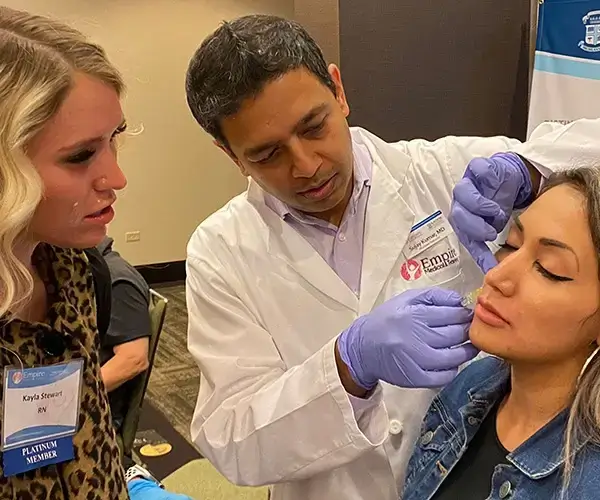Common Lip Filler Reactions and How to Avoid Them
By Dr. Stephen Cosentino
PRESIDENT OF EMPIRE MEDICAL TRAINING
Dermal filler treatment for the lips is safer than traditional plastic surgery and more permanent forms of lip augmentation, such as lip implants. But lip filler reactions can and do occur.
Most such reactions are mild, but some can persist for days and others require medical attention. Learn how to spot common reactions, distinguish between mild and severe reactions, and reduce your risk of lip filler complications in the future.
Common Lip Filler Reactions: What to Look For
Most lip filler side effects are mild and temporary. They generally last 24 to 48 hours, though some patients experience reactions for several days following the cosmetic procedure.
The most common reactions to lip fillers are local to the injection site or sites and include:
- Swelling and bruising
- Redness or tenderness
- Itchiness
- Discoloration (often a bluish hue)
- Minor bleeding
- Cold sore reactivation caused by a minor, local immunize response
- Skin lumps and nodules (granulomas)
- Asymmetry of the lips caused by uneven distribution of filler
Lip Filler Reactions: When to Seek Medical Attention
Most lip filler reactions resolve on their own, but in rare cases, medical attention may be required.
Localized Allergic Reaction
Signs of an acute local reaction to hyaluronic acid fillers (or other filler types) include sudden lip swelling, numbness, rash, and persistent nodule formation. Such reactions may be caused by other ingredients in the filler preparation, such as lidocaine, but only a trained medical professional can make that determination.
Systemic Allergic Reaction
In very rare cases, a filler ingredient can cause a systemic allergic reaction that may become life-threatening. Signs include facial swelling, widespread rash, and difficulty breathing. Seek immediate medical attention.
Infection and Necrosis
These reactions take longer to develop. Watch for redness, bleeding, and/or swelling that doesn’t go away within a few days. Other signs include:
- Cloudy discharge from the injection site
- Noticeable pain or tenderness around the injection site
- Injection site skin that feels warm to the touch
- Fever, swollen lymph nodes, and other symptoms of systemic infection
Untreated infections can lead to serious illness or skin necrosis (skin death) around the affected area, so timely medical attention is critical.
Blood Clotting
Blood clotting may occur if your provider injects lip filler into a major blood vessel. This increases cardiovascular risk and may also cause skin necrosis. Again, timely medical attention is critical.
How to Avoid Lip Filler Reactions
Post-treatment reaction is always a possibility, but you can reduce your risk by doing the following:
- Avoiding synthetic lip fillers in favor of hyaluronic acid fillers, which are less likely to provoke an allergic response
- Tell your provider if you’re allergic to lidocaine, a common cause of filler reactions
- Keep the injection site clean after treatment
- Apply an ice pack to control bruising and swelling
- Gently massage the treated area to reduce bumps and lumps
- Return to your provider if lumps persist — they can inject a safe substance to dissolve them
You’ll also be less likely to experience lip filler reactions of any kind if you work with a board-certified plastic surgeon or other medical provider with extensive training.
General dermal filler training courses should cover basic lip augmentation techniques and dermal filler procedures, but for best results, look for providers who are also certified in advanced lip filler techniques. Some aesthetic professionals specialize in lip fillers, and they know their craft.


